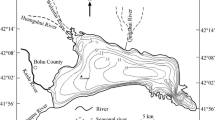Abstract
Five test runs were performed to assess possible bias when performing the loss on ignition (LOI) method to estimate organic matter and carbonate content of lake sediments. An accurate and stable weight loss was achieved after 2 h of burning pure CaCO3 at 950 °C, whereas LOI of pure graphite at 530 °C showed a direct relation to sample size and exposure time, with only 40-70% of the possible weight loss reached after 2 h of exposure and smaller samples losing weight faster than larger ones. Experiments with a standardised lake sediment revealed a strong initial weight loss at 550 °C, but samples continued to lose weight at a slow rate at exposure of up to 64 h, which was likely the effect of loss of volatile salts, structural water of clay minerals or metal oxides, or of inorganic carbon after the initial burning of organic matter. A further test-run revealed that at 550 °C samples in the centre of the furnace lost more weight than marginal samples. At 950 °C this pattern was still apparent but the differences became negligible. Again, LOI was dependent on sample size.
An analytical LOI quality control experiment including ten different laboratories was carried out using each laboratory's own LOI procedure as well as a standardised LOI procedure to analyse three different sediments. The range of LOI values between laboratories measured at 550 °C was generally larger when each laboratory used its own method than when using the standard method. This was similar for 950 °C, although the range of values tended to be smaller. The within-laboratory range of LOI measurements for a given sediment was generally small. Comparisons of the results of the individual and the standardised method suggest that there is a laboratory-specific pattern in the results, probably due to differences in laboratory equipment and/or handling that could not be eliminated by standardising the LOI procedure.
Factors such as sample size, exposure time, position of samples in the furnace and the laboratory measuring affected LOI results, with LOI at 550 °C being more susceptible to these factors than LOI at 950 °C. We, therefore, recommend analysts to be consistent in the LOI method used in relation to the ignition temperatures, exposure times, and the sample size and to include information on these three parameters when referring to the method.
Similar content being viewed by others
References
Ball, D. F., 1964. Loss-on-ignition as an estimate of organic matter and organic carbon in non-calcareous soils. J. Soil Sci. 15: 84–92.
Belis, C. A., A. Lami, P. Guilizzoni, D. Ariztegui & W. Geiger, 1999. The late Pleistocene ostracod record of the crater sediments from Lake Albano (Central Italy): changes in trophic status, water level and climate. J. Paleolim. 21: 151–169.
Bengtsson, L. & M. Enell, 1986. Chemical analysis. In Berglund, B. E. (ed.), Handbook of Holocene Palaeoecology and Palaeohydrology. John Wiley & Sons Ldt., Chichester, 423–451.
Dean, W. E. Jr., 1974. Determination of carbonate and organic matter in calcareous sediments and sedimentary rocks by loss on ignition: Comparison with other methods. J. Sed. Petrol. 44: 242–248.
Henderson, P. J. & W. M. Last, 1998. Holocene sedimentation in Lake Winnipeg, Manitoba, Canada: implications of compositional and textural variations. J. Paleolim. 19: 265–284.
Korhola, A., A. F. Lotter, H. J. B. Birks & N. G. Cameron, 1999. Climate history as recorded by ecologically sensitive arctic and alpine lakes in Europe during the last 10,000 years: a multiproxy approach (CHILL-10,000). In Proceedings of the European Climate Science Conference, Vienna, City Hall, 19- 23 October 1998 (in press).
Korsman, T., M. B. Nilsson, K. Landgren & I. Renberg, 1999. Spatial variability in surface sediment composition characterised by near-infrared (NIR) reflectance spectroscopy. J. Paleolim. 21: 61–71.
Lamoureux, S., 1999. Spatial and interannual variations in sedimentation patterns recorded in nonglacial varved sediments from the Canadian high arctic. J. Paleolim. 21: 73–84.
Mortimer, C. E., 1983. Chemie - Das Basiswissen der Chemie in Schwerpunkten. Georg Thieme Verlag, Stuttgart, 637 pp.
Spaulding, S. A., D. M. McKnight, E. F. Stoermer & P. T. Doran, 1997. Diatoms in sediments of perennially ice-covered Lake Hoare, and implications for interpreting lake history in the McMurdo Dry Valleys of Antarctica. J. Paleolim. 17: 403–420.
Sutherland, R. A., 1998. Loss-on-ignition estimates of organic matter and relationships to organic carbon in fluvial bed sediments. Hydrobiologia 389: 153–167.
Virkanen, J., A. Korhola, M. Tikkanen & T. Blom, 1997. Recent environmental changes in a naturally acidic rocky lake in southern Finland, as reflected in its sediment geochemistry and biostratigraphy. J. Paleolim. 17: 191–213.
Walker, I. R., E. D. Reavie, S. Palmer & R. N. Nordin, 1993. A paleoenvironmental assessment of human impact on Wood Lake, Okanagan Valley, British Columbia, Canada. Quat. Int. 20: 51–70.
Wathne, B. M., S. T. Patrick, D. Monteith & H. Barth (eds), 1995. AL:PE - Acidification of mountain lakes: Palaeolimnology and Ecology. AL:PE 1 report for the period April 1991- April 1993. Ecosystem Research Report 9, European Commission, Directorate-General for Science, Research and Development, Luxembourg, 296 pp.
Weliky, K., E. Suess, C. A. Ungerer, P. J. Mü ller & K. Fischer, 1983. Problems with accurate carbon measurements in marine sediments and particulate organic matter in sea water: a new approach. Limnol. Oceanogr. 28: 1252–1259.
Author information
Authors and Affiliations
Rights and permissions
About this article
Cite this article
Heiri, O., Lotter, A.F. & Lemcke, G. Loss on ignition as a method for estimating organic and carbonate content in sediments: reproducibility and comparability of results. Journal of Paleolimnology 25, 101–110 (2001). https://doi.org/10.1023/A:1008119611481
Issue Date:
DOI: https://doi.org/10.1023/A:1008119611481




